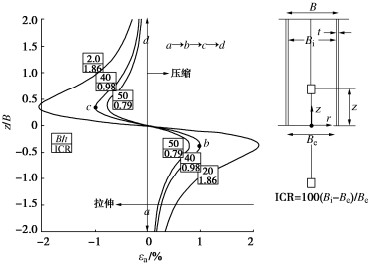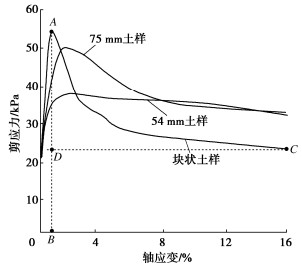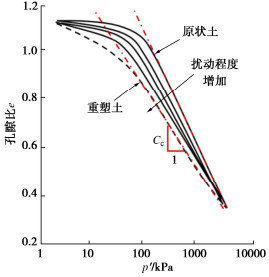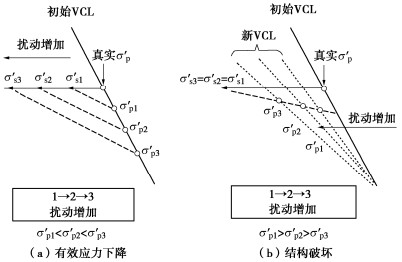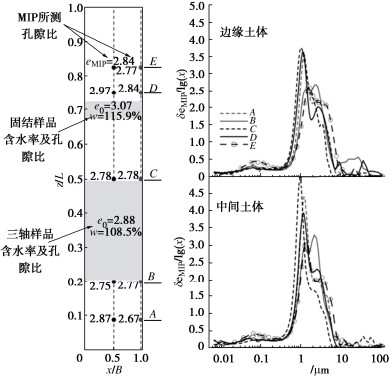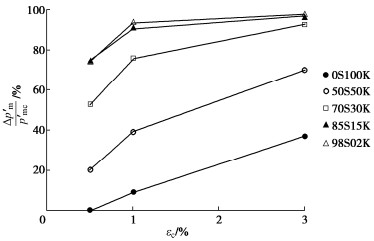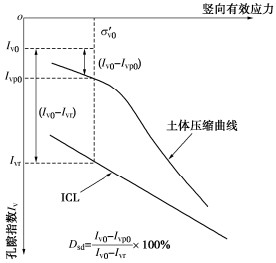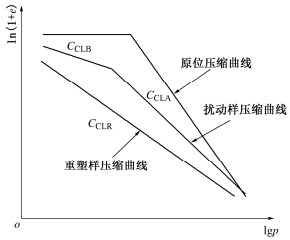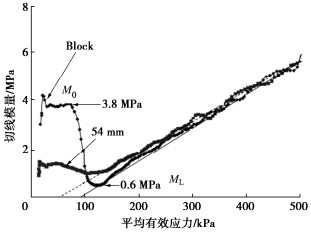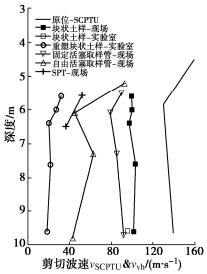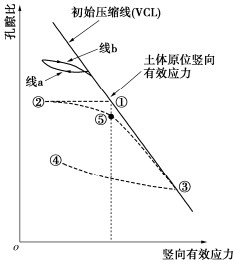Research progress on disturbance mechanisms, evaluation methods and control measures for sampling of soft clay
-
摘要: 软黏土由于具有含水率高、压缩性强、灵敏度高等特点使其在取样过程中易受到扰动,导致土体的强度及变形特性显著改变。了解取样扰动的力学机理、减少取样扰动影响并对土样质量进行合理评估对于确定工程设计中有代表性的土体参数具有重要意义。为此,总结了国内外软黏土取样扰动相关的研究进展,具体包括软黏土取样扰动因素及力学机理、取样扰动影响的宏微观表现、扰动程度的评估方法以及减少扰动的措施。研究表明:目前针对取样扰动宏观力学机理的研究成果颇丰,但缺乏相应的微观试验证据及微观机理分析对宏观结果进行佐证;现存土样质量评估指标大都只针对纯黏土,对粉质黏土、粉土等低塑性中间土体的适用性存疑,目前仍没有针对不同性质土体的统一土样质量评价体系;室内再固结方法可以有效减少取土过程中的应力释放影响,但无法恢复附加扰动破坏的土体结构。基于此,对今后亟待开展的研究提出了4点建议与展望。Abstract: The soft clay, characterized by high moisture content, strong compressibility and high sensitivity, is prone to disturbance during the sampling process, resulting in significant changes in the strength and deformation characteristics of soils. Understanding the mechanical mechanism behind sampling disturbance, reducing its impact and accurately evaluating the sample quality are crucial for determining the representative soil parameters in engineering design. To address these issues, the current researches on sampling disturbance in soft clay are summarized, including the mechanical mechanisms of sampling disturbance, the macroscopic and microscopic effects, the methods for the sample quality evaluation and the strategies to reduce disturbance. The researches show that there are abundant results on the macroscopic mechanical mechanisms of sampling disturbance. However, there is a lack of corresponding microscopic experimental evidence and analysis to support these macroscopic results. Furthermore, the most existing quality evaluation indices are designed for the clay and may not applicable to the low-plasticity intermediate soils such as silty clay and silt. Currently, there is still no unified quality evaluation system for the soil samples with varying properties. The reconsolidation methods can effectively reduce the stress release during the soil sampling process, but they cannot restore the soil structure damaged by sampling disturbance. Based on this, four suggestions and prospects for future researches are proposed.
-
Keywords:
- soft clay /
- sampling disturbance /
- sample quality evaluation /
- reconsolidation method
-
0. 引言
各向异性是黏土的基本性质之一,分为原生各向异性和次生各向异性。针对原生各向异性对黏土力学性状的影响,许多学者对与沉积平面呈不同夹角试样进行压缩、无侧限压缩和三轴压缩等试验,发现原生各向异性对黏土变形以及强度特性的影响不容忽视。
小应变剪切模量特性作为土的重要力学性质之一,也同样受到原生各向异性的影响。Simpson等[1]的研究表明,小应变剪切模量的原生各向异性对隧道及基坑周围土体变形的预测结果影响很大;Jovičić等[2]和吴宏伟等[3]分别针对伦敦黏土和上海软黏土进行研究,利用弯曲元测得两种土在低围压下水平和竖直方向上的最大剪切模量比值分别为1.5和1.21,说明对于不同种类黏土,原生各向异性对其小应变剪切模量的影响不尽相同。
结构性黏土在我国东南沿海地区分布广泛,许多工程建设涉及到此类黏土,迄今已对其小应变剪切模量进行了诸多研究,但以往的研究主要考虑孔隙比、应力水平和结构损伤等对小应变剪切模量的影响[4],而考虑原生各向异性对小应变剪切模量影响的研究较少,有必要进行系统探究。
本文对不同削样方向的湛江黏土原状试样开展不同围压下的共振柱试验,研究原生各向异性对最大动剪切模量的影响以及考虑原生各向异性的最大动剪切模量随围压演化规律的表征方法。
1. 试验材料与试验方案
1.1 试验材料与试样制备
土样取自湛江市某基坑内地下10~11 m,尺寸为30 cm×30 cm×30 cm原状块状样。表1为其基本物理力学指标与颗粒组成。由表1可见,湛江黏土具有较差物理性质,与软黏土相似,但力学性质较优,呈现上述特性的原因为其具有的强结构性[4]。
表 1 湛江黏土平均物理力学性质指标与颗粒组成Table 1. Physical and mechanical indexes and particle composition of Zhanjiang clay重度γ/(kN·m-3) 含水率w/% 孔隙比e 渗透系数K/(cm·s-1) 液限wL/% 塑限wP/% 塑性指数IP 结构屈服应力σk/kPa 无侧限抗压强度/kPa 灵敏度St 颗粒组成/% >0.05/mm 0.005~0.05/mm 0.002~0.005/mm <0.002/mm 17.1 52.98 1.44 2.73×10−8 59.6 28.1 31.5 400 143.5 7.2 8.2 39.5 20.7 31.6 图1(a)为不同方向圆柱试样示意图,定义试样轴线与土体沉积平面夹角为
α ,即竖直方向试样为90°,水平方向试样为0°。针对α 为0°,22.5°,45°,67.5°,90°方向原状样进行研究,试样规格尺寸为直径50 mm,高度100 mm的圆柱体。1.2 试验方法
试验所用设备为GDS共振柱仪,如图1(b)所示。试样的边界条件为一端固定,一端自由。通过电磁驱动系统对试样逐级施加扭矩,测得试样的共振频率和对应的剪应变,试样动剪切模量由下式得到:
G=ρ(2πfH/β)2, (1) 式中,G为试样动剪切模量,ρ为试样密度,f为共振频率,H为试样高度,β为扭转振动频率方程特征值。
试样在抽气饱和后安装至共振柱仪上,随后进行反压饱和,当B值达0.98后,进行固结,围压分别设定为50,100,200,300,400,500,600,700,800 kPa。试样固结完成后,进行共振柱试验。
2. 试验结果与分析
2.1 不同方向试样G-
γ 曲线规律如图2所示,不同方向试样动剪切模量G和剪应变
γ 的关系曲线形态与规律类似。剪切模量在小剪应变下衰减速度较小;随剪应变发展,衰减速度增大。低围压下G-γ 曲线随围压增大而上移,围压超过600~700 kPa,G-γ 曲线随围压增长而下移,与通常软黏土G-γ 曲线大多随围压增大而单调上移规律存在明显差异,说明结构性对湛江黏土G-γ 曲线规律影响较大。2.2 原生各向异性对最大动剪切模量的影响
湛江黏土动应力-应变关系可用Hardin-Drnevich双曲线模型表征,如下式:
τ=γa+bγ, (2) 式中,a,b为拟合参数。式(2)可以写为
1/G=a+bγ。 (3) 式(3)中,当
γ 趋近于0时,得到最大动剪切模量Gmax=1/a,利用式(3)求得不同方向试样在各围压下的Gmax。为了消除孔隙比对Gmax的影响,引入孔隙比函数F(e)=1/(0.3+0.7e2)将Gmax进行归一化处理,图3为经孔隙比函数归一化的Gmax/F(e)-围压σ3 曲线。随围压增大,不同方向试样Gmax/F(e)-σ3 曲线均呈现先上升后下降的规律,在围压为400~500 kPa即在σk 左右时,曲线出现转折。为了更好描述原生各向异性对最大动剪切模量的影响,定义Gmax/F(e)的原生各向异性系数:
Kα=Dα/D90°, (4) 式中,Dα定义为α方向试样的Gmax/F(e),D90°定义为90°(竖直)方向试样的Gmax/F(e)。
Gmax/F(e)的原生各向异性系数Kα与围压的关系如图4所示。相同围压下,Kα随方向角
α 变化,Kα整体上随α 增大而减小,即试样的方向越靠近水平其刚度越大,说明原生各向异性对湛江黏土最大动剪切模量Gmax的影响十分显著。湛江黏土基本单元为扁平状片堆、粒状碎屑矿物与单片颗粒,上述基本单元在沉积时,其长轴更倾向于水平方向,导致颗粒间水平方向的接触更紧密,结构更强[3],进而更靠近水平方向试样的刚度更大。当围压低于400~600 kPa时,同一方向试样Kα随围压增长基本保持恒定,K0°,K22.5°,K45°,K67.5°,K90°分别为1.314,1.279,1.148,1.045,1;当围压高于400~600 kPa时,同一方向试样Kα随围压增长呈明显减小趋势,不同方向试样的Gmax/F(e)差异减小。说明围压低于
σk 时,围压的增大几乎不影响原生各向异性对Gmax的影响,但当围压超过σk 后,围压的增大减弱了原生各向异性对Gmax的影响。文献[2]中伦敦黏土在围压超过屈服应力后,其水平与竖直方向试样的最大剪切模量的差异随围压增长也呈减小趋势,与本文试验结果一致。2.3 考虑原生各向异性的最大动剪切模量表征方法
图3中出现Gmax/F(e)随围压增大呈先上升后下降的特殊现象,文献[4]认为Gmax同时受到平均有效应力、孔隙比和结构损伤的影响,采用该文的表征方法对试验结果进行分析,具体的表达形式如下所示:
Gmax/F(e)=A(1+(σ′mpa)n)1+B(1+(σ′mpa)n)(kr+1−kr1+(ησ′mpc)λ)。 (5) 式中 A,B,n,kr,η和
λ 为反映各种应力历史和土体性质的参数;σ′m 为围压;pa为标准大气压;pc为表观前期固结压力即结构屈服应力σk ,不同方向试样压缩试验得到的σk 差异较小,均取400 kPa。采用式(5)将不同方向试样Gmax/F(e)与围压的关系进行定量表征。从图4可得,高应力下各向异性对试样的Gmax/F(e)影响减弱,可假定不同方向试样Gmax/F(e)极限值相同。最终将试验数据与拟合曲线一同绘制于图5,发现拟合效果很好,拟合参数见表2。
表 2 不同方向试样拟合参数Table 2. Fitting parameters of specimens in different directionsα A/MPa B n kr η λ R2 0° 39.92489 0.16678 0.54309 0.35092 0.56433 6.42998 0.99251 22.5° 37.89951 0.15999 0.58264 0.35462 0.56426 6.37147 0.99075 45° 33.76328 0.15168 0.54642 0.37740 0.55402 6.38473 0.99432 67.5° 31.15476 0.15761 0.56254 0.42499 0.60889 6.07737 0.99727 90° 29.75422 0.15743 0.56067 0.44448 0.57750 6.05669 0.99835 分析表2中拟合参数与试样方向的关系,可得参数A,kr,
λ 和试样轴线与土体沉积平面夹角α 呈线性关系(图6),参数B,n,η随α 增大分别保持在0.1587,0.5591,0.5738上下,且波动范围较小(参数B,n,η的标准差S分别为0.005455,0.01570和0.02131)。将图6中参数A,kr,
λ 的拟合方程和参数B,n,η的平均值同时代入式(5),得到考虑原生各向异性的最大动剪切模量的表征方法:Gmax/F(e)=(c1α+c2)(1+(σ′mpa)n)1+B(1+(σ′mpa)n)· ((d1α+d2)+1−(d1α+d2)1+(ησ′mpc)(e1α+e2))。 (6) 式中
σ′m 为围压;α 表示试样的方向,为试样轴线与土体沉积平面夹角;pa为标准大气压,取101.325 kPa;pc为σk ,取400 kPa;B=0.1587,n=0.5591,η=0.5738;c1=−0.1204,c2=39.9166;d1=1.144×10−3,d2=0.3390;e1=−4.625×10−3,e2=6.4722。3. 结论
(1)在同一围压下,不同
α 试样经孔隙比函数归一化的最大动剪切模量Gmax/F(e)与90°方向试样Gmax/F(e)的比值Kα随α 增大而减小。当围压低于和高于σk 时,同一α 试样Kα随围压增长分别呈基本保持恒定与明显减小趋势,说明当围压低于σk 时,围压几乎不影响原生各向异性对Gmax影响,围压超过σk 后,不同方向的Gmax/F(e)差异减小,围压的增大减弱了原生各向异性对Gmax的影响。(2)受固结压硬和结构损伤的影响,湛江黏土的Gmax/F(e)变化规律与通常软黏土试验结果不同,不同方向试样的Gmax/F(e)随围压增大均呈先增大后减小规律,当围压在
σk 左右时出现转折。(3)基于采用考虑结构损伤的公式可很好拟合湛江黏土不同方向试样Gmax与围压关系曲线,提出了考虑原生各向异性影响的Gmax演化规律表征方法。
-
图 1 ISA扰动原理图[5]
Figure 1. Schematic diagram of ISA
图 3 不同取样方式下软黏土典型三轴不排水剪切试验结果[7]
Figure 3. Typical triaxial undrained shear test results of soft clay by different sampling methods
图 4 扰动作用下软黏土典型固结试验结果[10]
Figure 4. Oedometer test results of soft clay under disturbance
图 5 不同扰动形式对软黏土压缩行为影响示意图[11]
Figure 5. Schematic of effects of disturbance on compression behaviour
图 6 50 mm Shelby取样管土样试验结果[18]
Figure 6. Test results of 50 mm-Shelby sample
图 7 不同塑性土体受扰动后有效应力降低程度图[36]
Figure 7. Diagram of degree of effective stress reduction in soils with different plasticities under disturbance
图 8 基于孔隙指数的土样质量评价指标[24]
Figure 8. Indices of sample quality evaluation based on void index
图 9 修正体积压缩法扰动度定义[25]
Figure 9. Definition of modified volume compression method
图 10 M0/ML指标定义[9]
Figure 10. Definition of M0/ML
图 11 通过SCPTU和弯曲元在不同样品上测量的土体剪切波速剖面图[15]
Figure 11. Measured shear wave velocity profiles of different samples using SCPTU and bending elements
图 12 取土扰动影响示意图[37]
Figure 12. Schematic diagram of sampling disturbance effects on compression curve of soils
表 1 54 mm取土管样品与高质量块状样品的强度对比[9]
Table 1 Strengths of 54 mm-piston sample as compared to block samples of high quality
试验类型 高于54 mm取土管样品强度/% CAUC 10~50 CAUE 0~10 DSS 5~20 表 2 5种合成土体的物理指标[21]
Table 2 Physical parameters of five synthetic soils
土体 wL/
%wP/
%Ip/
%细粒含量/
%土体分类 0S100K 59 25 34 100 CH 50S50K 31 15 16 88 CL 70S30K 24 15 9 83 CL 85S15K 19 15 4 79 CL-ML 98S02K 18 NP NP 75 ML 注:wL为液限,wP为塑限,Ip为塑性指数,细粒: < 0.075 mm。 表 3 Δe/e0土样质量评价指标[7]
Table 3 Sample quality evaluation based on Δe/e0
OCR=1~2 OCR=2~4 评级 <0.04 <0.03 very good to excellent 0.04~0.07 0.03~0.05 good to fair 0.07~0.14 0.05~0.10 poor >0.14 >0.10 very poor -
[1] 李广信, 张丙印, 于玉贞. 土力学[M]. 北京: 清华大学出版社, 2013. LI Guangxin, ZHANG Bingyin, YU Yuzhen. Soil mechanics[M]. Beijing: Tsinghua University Press, 2013. (in Chinese)
[2] HVORSLEV M J. Subsurface exploration and sampling of soil for civil engineering purposes[C]// Waterways Experiment Station. Vicksburg, 1949.
[3] SKEMPTON A W, SOWA V A. The behaviour of saturated clays during sampling and testing[J]. Géotechnique, 1963, 13(4): 269-290. doi: 10.1680/geot.1963.13.4.269
[4] LADD C C, LAMBE T W. The strength of "undisturbed" clay determined from undrained tests[M]//Laboratory Shear Testing of Soils. 100 Barr Harbor Drive, PO Box C700, West Conshohocken, PA 19428-2959: ASTM International, 2009: 342-342-30.
[5] BALIGH M M, AZZOUZ A S, CHIN C T. Disturbances due to "ideal" tube sampling[J]. Journal of Geotechnical Engineering, 1987, 113(7): 739-757. doi: 10.1061/(ASCE)0733-9410(1987)113:7(739)
[6] BALIGH M M. Strain path method[J]. Journal of Geotechnical Engineering, 1985, 111(9): 1108-1136. doi: 10.1061/(ASCE)0733-9410(1985)111:9(1108)
[7] LUNNE T, BERRE T, STRANDVIK S. Sample disturbance effects in soft low plastic Norwegian clay[C]// Recent developments in soil and pavement mechanics, Ria de Janeiro, Brazil, 1997: 81-102.
[8] LUNNE T, BERRE T, ANDERSEN K H, et al. Effects of sample disturbance and consolidation procedures on measured shear strength of soft marine Norwegian clays[J]. Canadian Geotechnical Journal, 2006, 43(7): 726-750. doi: 10.1139/t06-040
[9] KARLSRUD K, HERNANDEZ-MARTINEZ F G. Strength and deformation properties of Norwegian clays from laboratory tests on high-quality block samples[J]. Canadian Geotechnical Journal, 2013, 50(12): 1273-1293. doi: 10.1139/cgj-2013-0298
[10] RUTLEDGE P C. Relation of undisturbed sampling to laboratory testing[J]. Transactions of the American Society of Civil Engineers, 1944, 109(1): 1155-1183. doi: 10.1061/TACEAT.0005758
[11] SANTAGATA M C, GERMAINE J T. Sampling disturbance effects in normally consolidated clays[J]. Journal of Geotechnical and Geoenvironmental Engineering, 2002, 128(12): 997-1006. doi: 10.1061/(ASCE)1090-0241(2002)128:12(997)
[12] 顾晓强, 杨峻, 黄茂松, 等. 砂土剪切模量测定的弯曲元、共振柱和循环扭剪试验[J]. 岩土工程学报, 2016, 38(4): 740-746. doi: 10.11779/CJGE201604020 GU Xiaoqiang, YANG Jun, HUANG Maosong, et al. Combining bender element, resonant column and cyclic torsional shear tests to determine small strain shear modulus of sand[J]. Chinese Journal of Geotechnical Engineering, 2016, 38(4): 740-746. (in Chinese) doi: 10.11779/CJGE201604020
[13] 王建华, 程国勇, 张立. 取样扰动引起土层剪切波速变化的试验研究[J]. 岩石力学与工程学报, 2004, 23(15): 2604-2608. WANG Jianhua, CHENG Guoyong, ZHANG Li. Study on variation of shear wave velocity caused by sampling disturbance[J]. Chinese Journal of Rock Mechanics and Engineering, 2004, 23(15): 2604-2608. (in Chinese)
[14] DONOHUE S, LONG M. Assessment of sample quality in soft clay using shear wave velocity and suction measurements[J]. Géotechnique, 2010, 60(11): 883-889. doi: 10.1680/geot.8.T.007.3741
[15] HORNG V, TANAKA H, OBARA T. Effects of sampling tube geometry on soft clayey sample quality evaluated by nondestructive methods[J]. Soils and Foundations, 2010, 50(1): 93-107. doi: 10.3208/sandf.50.93
[16] DONOHUE S, LONG M. Suction measurements as indicators of sample quality in soft clay[J]. Geotechnical Testing Journal, 2009, 32(3): 286-296. doi: 10.1520/GTJ101416
[17] DONOHUE S, LONG M. Suction measurements as indicators of sample quality in soft clay[J]. Geotechnical Testing Journal, 2009, 32(3): 286-296. doi: 10.1520/GTJ101416
[18] PINEDA J A, LIU X F, SLOAN S W. Effects of tube sampling in soft clay: a microstructural insight[J]. Géotechnique, 2016, 66(12): 969-983. doi: 10.1680/jgeot.15.P.217
[19] KONNI G R. Influence of soil properties and composition, and applied hydraulic pressures on sample quality of Pusan clays[J]. European Journal of Engineering and Technology Research, 2017, 2(1): 32-38.
[20] SANTAGATA M, GERMAINE J T. Effect of OCR on sampling disturbance of cohesive soils and evaluation of laboratory reconsolidation procedures[J]. Canadian Geotechnical Journal, 2005, 42(2): 459-474. doi: 10.1139/t04-104
[21] LUKAS W G, DEGROOT D J, DEJONG J T, et al. Undrained shear behavior of low-plasticity intermediate soils subjected to simulated tube-sampling disturbance[J]. Journal of Geotechnical and Geoenvironmental Engineering, 2019, 145(1): 04018098. doi: 10.1061/(ASCE)GT.1943-5606.0001967
[22] ANDRESEN A. The NGI 54-mm samplers for undisturbed sampling of clays and representative sampling of coarser materials, state of the art on current practice of soil sampling[C]// Progressing of The International Symposium of Soil Sampling, Singapore, 1979.
[23] HATHEWAY A. Soil Mechanics in Engineering Practice, 3rd Edition[M]. 2rd ed. New York: Wiley, 1996.
[24] HONG Z S, HAN J. Evaluation of sample quality of sensitive clay using intrinsic compression concept[J]. Journal of Geotechnical and Geoenvironmental Engineering, 2007, 133(1): 83-90. doi: 10.1061/(ASCE)1090-0241(2007)133:1(83)
[25] HONG Z S, ONITSUKA K. A method of correcting yield stress and compression index of ariake clays for sample disturbance[J]. Soils and Foundations, 1998, 38(2): 211-222. doi: 10.3208/sandf.38.2_211
[26] BUTTERFIELD R. A natural compression law for soils (an advance on e-lgp')[J]. Géotechnique, 1979, 29(4): 469-480. doi: 10.1680/geot.1979.29.4.469
[27] DEJONG J T, KRAGE C P, ALBIN B M, et al. Work-based framework for sample quality evaluation of low plasticity soils[J]. Journal of Geotechnical and Geoenvironmental Engineering, 2018, 144(10): 04018074. doi: 10.1061/(ASCE)GT.1943-5606.0001941
[28] TSUCHIDA T. Evaluation of undrained shear strength of soft clay with consideration of sample quality[J]. Soils and Foundations, 2000, 40(3): 29-42. doi: 10.3208/sandf.40.3_29
[29] CARROLL R, LONG M. Sample disturbance effects in silt[J]. Journal of Geotechnical and Geoenvironmental Engineering, 2017, 143(9): 04017061. doi: 10.1061/(ASCE)GT.1943-5606.0001749
[30] 杨守华, 魏汝龙. 土样扰动对正常固结黏土强度及压缩特性的影响[J]. 水利水运科学研究, 1992(1): 73-83. YANG Shouhua, WEI Rulong. Influence of sampling disturbances on strength and consolidation behavior of normally consolidated clay[J]. Hydro-Science and Engineering, 1992(1): 73-83. (in Chinese)
[31] LEFEBVRE G, POULIN C. A new method of sampling in sensitive clay[J]. Canadian Geotechnical Journal, 1979, 16(1): 226-233. doi: 10.1139/t79-019
[32] ROCHELLE P L, SARRAILH J, TAVENAS F, et al. Causes of sampling disturbance and design of a new sampler for sensitive soils[J]. Canadian Geotechnical Journal, 1981, 18(1): 52-66. doi: 10.1139/t81-006
[33] TANAKA H, SHARMA P, TSUCHIDA T, et al. Comparative study on sample quality using several types of samplers[J]. Soils and Foundations, 1996, 36(2): 57-68. doi: 10.3208/sandf.36.2_57
[34] 高大钊, 张少钦, 姜安龙, 等. 取样扰动对土的工程性质指标影响的试验研究[J]. 工程勘察, 2006, 34(3): 6-10. GAO Dazhao, ZHANG Shaoqin, JIANG Anlong, et al. Experimental study on influence of sampling disturbance to indices for engineering properties of soils[J]. Journal of Geotechnical Investigation & Surveying, 2006, 34(3): 6-10. (in Chinese)
[35] 李高山, 潘永坚, 周江锋. 取样方法对饱和软土物理力学指标影响机理研究[J]. 工程勘察, 2019, 47(3): 9-16. LI Gaoshan, PAN Yongjian, ZHOU Jiangfeng. Study on the influence mechanism of sampling on physical and mechanical indexes of saturated soft soil[J]. Geotechnical Investigation & Surveying, 2019, 47(3): 9-16. (in Chinese)
[36] BJERRUM L. Problems of soil mechanics and construction on soft clays and structurally unstable soils (collapsible, expansive and others)[C]// The 8th International Conference on Computational Mechanics of Solids and Structures. Singapore, 1973.
[37] LADD C C, FOOTT R. New design procedure for stability of soft clays[J]. Journal of the Geotechnical Engineering Division, 1974, 100(7): 763-786.
[38] TANAKA H, SHIWAKOTI D R, TANAKA M. Applicability of shansep method to six different natural clays, using triaxial and direct shear tests[J]. Soils and Foundations, 2003, 43(3): 43-55.
-
其他相关附件



 下载:
下载:






